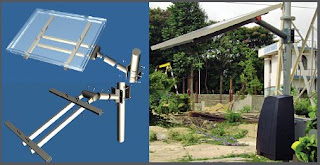These energy systems that are independent of the grid. Electricity is obtained from renewable energy sources like solar irradiation or wind, stored into batteries and converted into a suitable form for appliances or tools whenever required.
Our SolarLab is an off-grid PV system.
Off-grid systems may also include a mix of different energy sources. These are known as 'hybrid' systems. For example, some off-grid systems have backup diesel generators as supplements. The generators ensure that there is always enough power supply throughout the day and night, and to prevent batteries from being over-discharged.
PV Components
The various components involved for a typical off-grid system:
- Power generating units (e.g. PV modules, wind turbines)
- charge controllers
- connection boxes
- batteries
- inverters
- loads
For today's installation, we would focus on the setting up of the SunForte mounting structure, followed by the PV module installation thereafter. The entire installation would involve three different Conergy mounting structures:
- SunForte x 2
- SolarFamulus x 1
- Wifi PV arm x 1
SunForte, SolarFamulus and Wifi PV arm (as shown in order):



First to go up was the SunForte structure, which is usually used on flat, open ground spaces. But we decided to test it on this rooftop since it was also a flat and open surface. This structure had an inclination of 15 degrees.
------------------ Quick tip------------------
Due to our geographical position of 1 degree North of the equator, the position of the Sun remains very close to the zenith throughout the whole year. As such, the optimal inclination of PV arrays in the tropics should be 0 degrees to the horizontal. However in practice, most mounting structures are slightly inclined to at least 15 degrees for a self-cleaning surface (using rain) to prevent any build-up of dirt or debris on the top of the panels.
--------------------------------------------------------
Our first task of the day was to move the equipment out from storage: The lift landing area was used as our base of operations:
The lift landing area was used as our base of operations: Initial markings were made for the placement of the foundation plates:
Initial markings were made for the placement of the foundation plates: Joiner plates had to be attached to the 3.5m long aluminium rails. Unfortunately, we also had to conduct some drilling works on the rails. The ready-made bores through the rails were slightly off, and could not fit the joiner plates properly:
Joiner plates had to be attached to the 3.5m long aluminium rails. Unfortunately, we also had to conduct some drilling works on the rails. The ready-made bores through the rails were slightly off, and could not fit the joiner plates properly:
 We had two SunForte systems, but only one would be set up at this point in time. The first SunForte would be installed with the poly-silicon modules Yingli.
We had two SunForte systems, but only one would be set up at this point in time. The first SunForte would be installed with the poly-silicon modules Yingli.
 A short discussion about the dynamics of the Earth's orbit and how the Sun's overhead position in Singapore shifts slightly between the July-December and Jan-June periods:
A short discussion about the dynamics of the Earth's orbit and how the Sun's overhead position in Singapore shifts slightly between the July-December and Jan-June periods:
------------------ Quick tip ------------------
PV installations should either face 0 deg azimuth (True North) or 180 deg azimuth (True South), depending on which hemisphere. For example, all installations in Australia should face to the north because they are in the southern hemisphere; correspondingly, all installations should face to the South because they are in the northern hemisphere.
Singapore, on the other hand, is sitting very close to the equator, which means that the path of the Sun is slightly north of the zenith during the first half of the year (January - June) and slightly in the south for the next half (July - December) . In terms of solar radiation, the difference between facing North and South in Singapore is quite minimal. Our installation would be built facing the North.
Singapore, on the other hand, is sitting very close to the equator, which means that the path of the Sun is slightly north of the zenith during the first half of the year (January - June) and slightly in the south for the next half (July - December) . In terms of solar radiation, the difference between facing North and South in Singapore is quite minimal. Our installation would be built facing the North.
--------------------------------------------------------
Once the structure was set up, we could proceed to install the modules. As mentioned before, the Yingli modules were based on polycrystalline silicon technology:



 ------------------ Quick tip ------------------
------------------ Quick tip ------------------Poly-crystalline silicon (Poly-Si) is currently the most commonly used material for PV modules in the world today. Typical module efficiencies range between 10% - 14%. Compared to its predecessor technology of mono-crystalline silicon which can reach efficiencies between 14% - 17%, it is less efficient per unit area. However, since these are generally much cheaper to manufacture than mono-crystalline, Poly-Si are more popular amongst PV cell and module manufacturers.
--------------------------------------------------------
Water-ponding on the metal plates:
 This doesn't bode well for the lifetime of the structure in the long run. Concrete slabs might be a good alternative to these foundation plates.
This doesn't bode well for the lifetime of the structure in the long run. Concrete slabs might be a good alternative to these foundation plates.The weather wasn't too good that day with occasional showers and cloud lightnings. Towards late afternoon, huge thunderstorm clouds were fast approaching and we had to leave the installation due to safety concerns. Standing on the rooftop of a 8th-storey building during a thunderstorm was a definite occupational hazard!
We would continue with the installation in the following week.
No comments:
Post a Comment